Archive Section
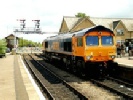


Wednesday 4th – Monday 9th July 2018.
© Text & Photos: Stuart Smith
Despite the best efforts of the Italian Railways to recreate a little slice of British Rail abroad (delays, cancellations and general disruption) I made my way from Milan Malpensa Airport to Göschenen via the newly opened border crossing at Stabio. My arrival was an hour later than planned, but with the stunning local scenery and the prospect of four excellent days of visits and travelling ahead, I wasn’t really that bothered with the delays. I had arranged for our group to stay for three nights in Göschenen, and then for a further two nights in Bellinzona.
The proprietors of the Hotel Chalet Krone were to be excellent hosts, who couldn’t do enough for our group. We were situated only three minutes from the railway station, so could not have been better located either. Sadly though, the rail line through the region is now a shadow of its former self, with virtually all freight traffic and most of the long distance passenger trains now running via the 57km Gotthard Basis Tunnel. A simple hourly local service is all that remains, although we did witness a couple of test trains, a fire rescue train and one ‘restricted’ freight trains, that presumably couldn’t use the new tunnel.
The next morning we gathered for breakfast and exchanged further stories around the table.
For our first official visit, we were heading for the SBB Works at Bellinzona. Our train, the 08:02 departure, was surprisingly formed of one of the older style Class 560 EMU’s, which have virtually all been replaced by the newer Stadler Rail ‘Flirt’ units.
Our arrival into Bellinzona coincided with the departure of the northbound ‘Gotthard Panoramic Express’ which runs from Lugano to Flüelen, and connects with one of the paddle steamers which continue across Lake Luzern. This train, hauled by Re4/4 11192, consists of mainly panoramic style coaches affording better views whilst travelling over the Gotthard Pass. Now joined by two other members, we took the short five-
After introductions (in perfect English on his behalf), we were shown around the outer buildings of the complex, where many ‘specialist’ jobs are undertaken. Here we saw Re6/6 620013 and Re4/4 420247 undergoing bodyside repairs. The works currently employs around 330 staff, but has been reduced significantly in recent years. Like many countries, Switzerland is starting to transform some traditional loco-
The Zurich area has seen considerable changes to its rail services in recent years, and a major refurbishment programme has taken place for certain locomotive-
Known as “Lion”, this has seen Bellinzona Works overhaul thirty Re420 locomotives to work in top and tail formation with double deck carriages during the peak hours. With this work virtually completed, staff are now involved with “Refit Re620” which involves life extension work for the freight/cargo locomotives. Each locomotive is stopped for around sixty days, and receives a total strip down and internal rebuild. All electrical components are renewed, and a new livery of ‘all-
Ten Re6/6 and Re4/4 have already been scrapped, with 11603, 11604, 11308 and 421396 all dumped on site awaiting their fate. Having been escorted and guided around the entire length of the works, (including viewing the three separate traverser’s they use), it was time to conclude our time with SBB, but not before being shown a piece of equipment, a threading machine dating from 1886, which is still used by maintenance staff today!
We headed back to the station, where I had allowed sufficient time for coffee, before our next train was due. Disentis/Muster was our afternoon destination, by way of changing trains at both Göschenen and Andermatt.
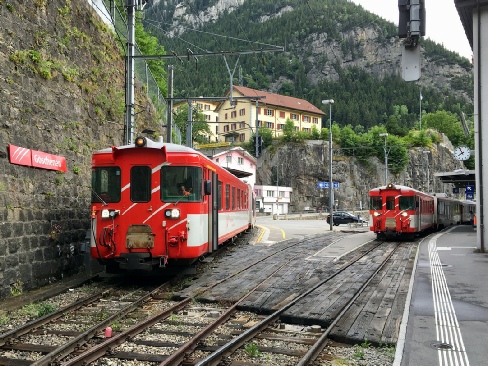
Two MGB services stand await departure towards Andermatt. Our accommodation whilst at Göschenen (Hotel Chalet Krone), is in the background
The route from Andermatt is quite steep and rack-
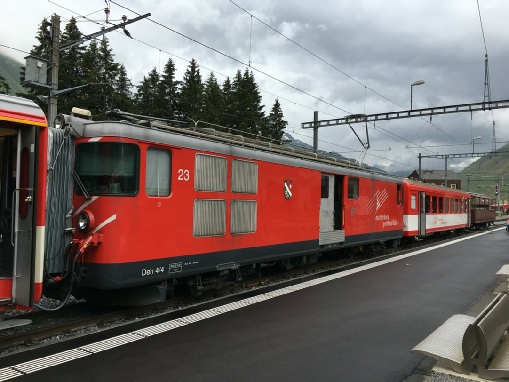
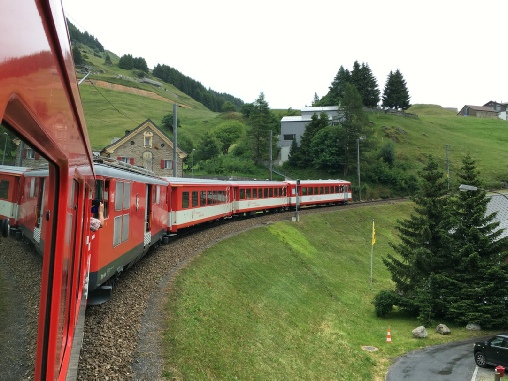
Our afternoon excursion to Disentis/Muster featured a train powered by a motor-
After an excellent visit here, and although still very hot, we opted for a slight detour on our homeward journey to take a ride on a special train operated by the Bern-
Even on a late Sunday afternoon, in the fairly short journey to Burgdorf, we passed four freight trains carrying road trailers (HUPAC). I commented that in our 30-
We said our goodbyes to the special at Burgdorf, and waited for a regular SBB service to Zurich. Upon our arrival into the main station, it was quickly noticed that our intended train back to Bellinzona was showing as ‘cancelled or delayed’. Fortunately we had time to rush across to catch the preceding train, (which was actually the stock to form the later train). It would seem that the inbound train from Milan was heavily delayed, and so, very sensibly, they were using the stock for the later train to depart on-
So, back in Bellinzona, we had our final evening. Unfortunately, the Italian part of Switzerland appears to close early on a Sunday, so we had to make do with a local pizza restaurant for our final meal of the trip. Although very acceptable it was indeed.
The following morning, we were all heading separate ways. I was flying home from Milan Linate Airport, so opted to travel via the branch line that runs from Como Nord Lago (at the foot of Lake Como). The weather was now even hotter in Northern Italy – 35’c at 10am.
My sincere thanks to all the venues we visited, and to all our hosts whilst in Switzerland, and especially to the members who participated in making this an enjoyable trip.
Other related web pages:
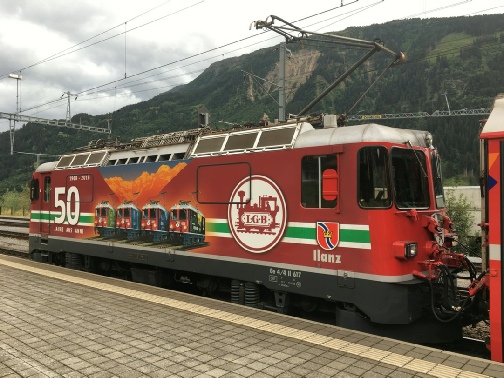
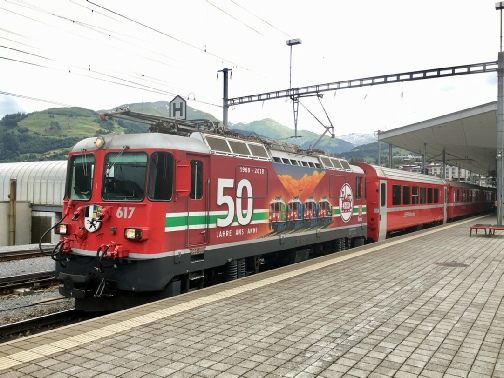
RhB Ge4/4 (number 617) stands at Disentis/Muster with a regional service heading for Scoul-
My original plan was to have an evening meal here, whilst overlooking the joint RhB/MGB station. Unfortunately, the lack of late evening return trains required us to leave by 18:14 at the latest, so we opted to have dinner back at our hotel. Our hosts provided another excellent evening meal; with Bratwurst, Rösti and Schnitzel all on offer. Homegrown pumpkin (grown locally by the Mother of the proprietor) also featured as an appetizer.
Next morning, the 08:02 train had reverted to one of the modern units (perhaps yesterday was a blip in diagramming), but, nonetheless, it was fairly quiet for the journey south to Bellinzona. Here we made the quick change to a loco hauled Lugano-
Even at 10:15am, the local Gelato stall outside the station was too tempting to pass up. Suitability refreshed, we took the short walk to the lakeside station. This 350metre extension is only served by one train per day -
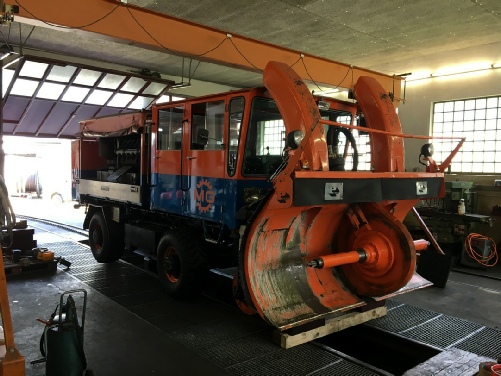
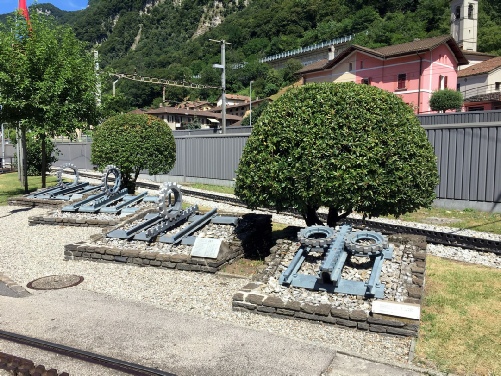
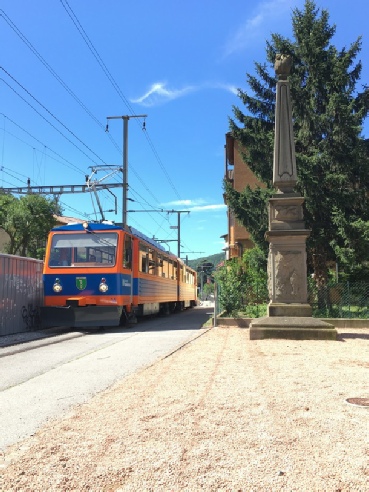
The Monte Generoso Railway service extends once a day to Capolago Lago station to connect with a cruise boat on Lake Lugano. Members walked from the main station at Capolago Riva S. Vitale where we discovered a display of varying types of rack railway. We also found our way inside the local depot, where a snow-
At just after 11:00am, the two-
The train then set off back to the main station in Capolago, where it filled to capacity for the ascent to Generoso Vetta. At 1,701metres above sea level, we reached the summit station with commanding views across the Swiss/Italian border regions. However, the railway station and observatory aren’t at the highest point, and so we climbed the remaining 150 metres, braving the 30’c heat in the process, to reach the lookout area.
After our exertions, we retreated back to the summit station and took rest with a welcome drink and lunch.
Suitably refreshed (again) we returned down to Capolago and made our way back to the lakeside station – this time on foot.
We had around thirty minutes to wait for our boat back to Lugano, and so the cool breeze coming across the lake was very welcome, although joining the fairly large group of locals using the dedicated swimming area would have been most welcome. Just before 16:00, the San Gottardo arrived and docked. We boarded and found seats on the open front deck. No sooner had we set sail, the waitress appeared taking orders for coffee, ice cream or prosecco!
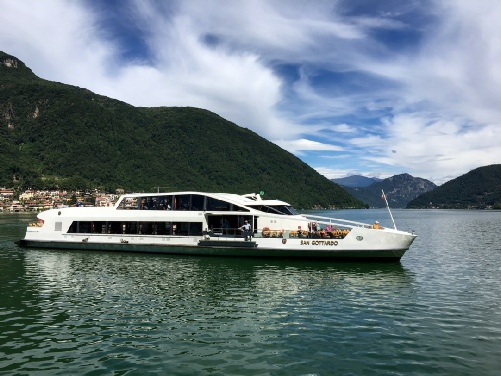
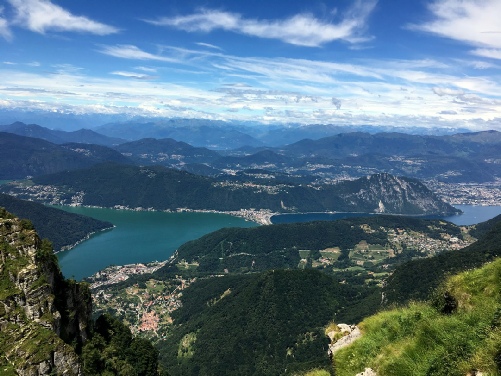
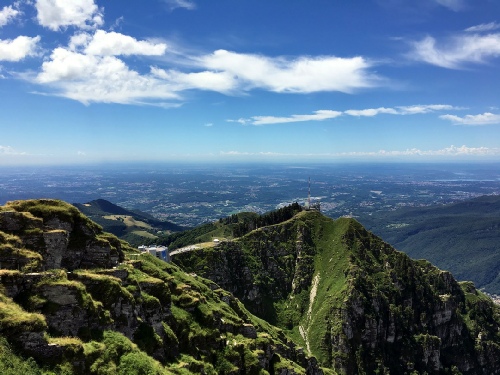
Views from the top of Monte Generoso
All aboard the San Gottardo for a cruise on Lake Lugano
The forty-
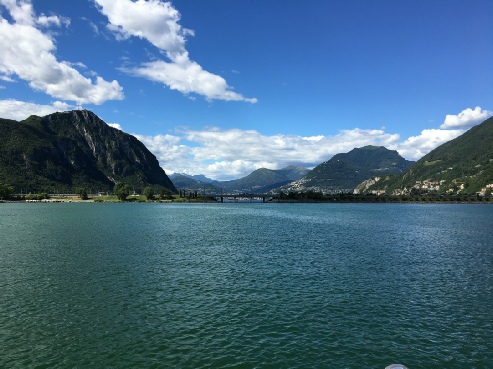
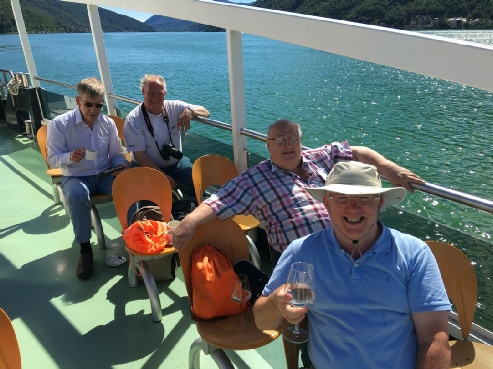
The views and L&CI members enjoying the prosecco on lake Lugano
Again, I had hoped to conclude the day with an evening meal for the group at the harbourside, but the lack of trains back to Göschenen prevented it. So, instead we rode up the city funicular railway and boarded an early evening train home. Our hosts at the Chalet Krone provided another excellent meal to round off a very pleasant and fulfilling day.
Saturday arrived, and I left the hotel before the rest of the group in order to sort the ticketing out for our day on the FurkaDampfBahn. The somewhat unusual process of reserving online, yet only paying in advance for part of the tickets (the return portion), left me wanting to make sure I had everything in place before members arrived an hour later. Swiss efficiency ensued, and within a few minutes of my arrival, I was in possession of everything I required, had met our host for the day, and was sat having a coffee in the station cafe.
I even had time to watch an MGB car shuttle train unload and reload for its journey through the Furka Basis Tunnel (the 1982 route built to supersede the old route we would be travelling via today). With the group now all present, we were introduced to Miss Nellen (the daughter of our intended host, and today’s Station Master). Through the arranging process for our educational visit, I had made contact with the FDB to seek permission for our group to ride in the cab of the locomotive. This had been approved, and so we were also introduced to the lokführer (locomotive engineer) Mr Bollinger, who welcomed members, two at a time, into his cab. Various features of the route and interesting facts were mentioned, whilst safely controlling the train through the stunning scenery. Even though it was early July, some huge deposits of snow and ice still remained along the route, clearly displaying why this former mainline route succumbed to the weather and was forced to close during the winter months. The retractable Steffenbach Bridge, near Tiefenbach, is still dismantled during the winter season to prevent damage by cascading snow in the area!
Reopening of the line was expensive, time consuming and completed partly in sections. In addition to the above mentioned bridge, the line features a retractable section of rack-
On arrival into Oberwald, an eastbound steam-
After a short break for coffee, we returned back to Gletsch (riding in the open sided coach behind the locomotive), where the train pauses for just over 2hours. This is to allow time for lunch, for both passengers and traincrew. So, along with the driver, fireman and other staff, we opted to visit the Hotel Glacier du Rhône, situated across from the station.
Sadly, we found out that beyond the impressive hotel, there isn’t actually much else on offer in this modern-
A little after 14:00, we walked back to the station to await our steam-
With reserved seating arranged for our group, we boarded, and set off for the long climb to Muttbach-
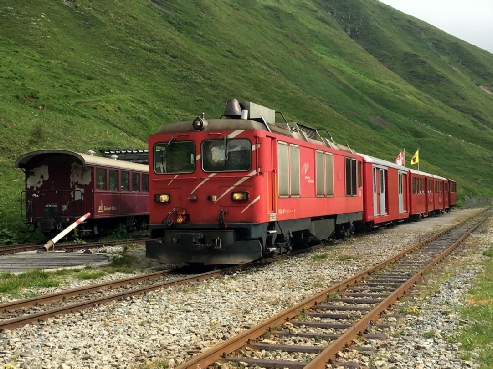
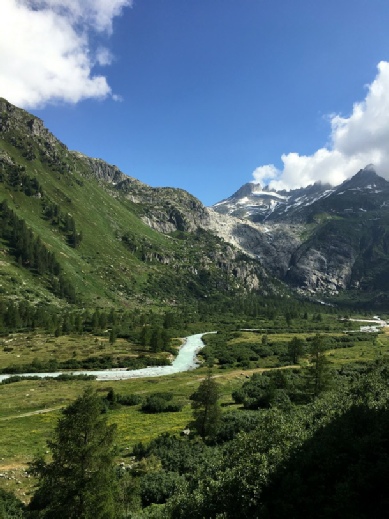
Hired-
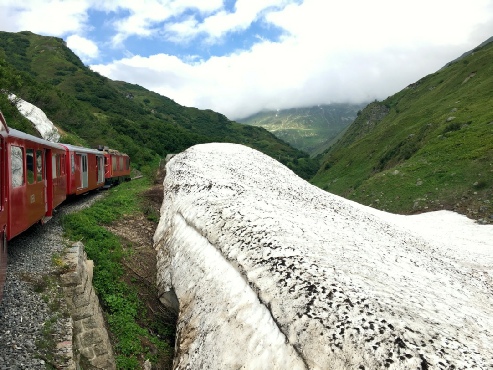
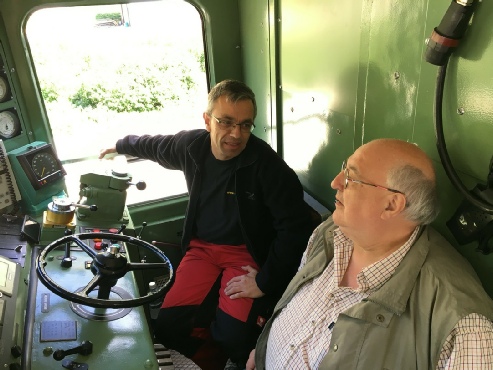
Our Chairman, Alan Spencer, chats to the driver, Mr Bollinger, during a station stop.
Members were permitted to ride in the cab (in pairs) for the Westbound journey over the mountain pass
Stunning scenery (and huge snow deposits which dwarf the train)
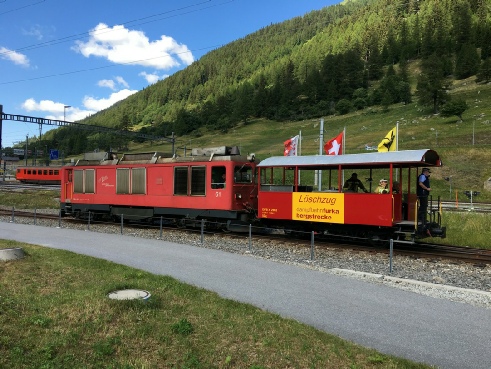
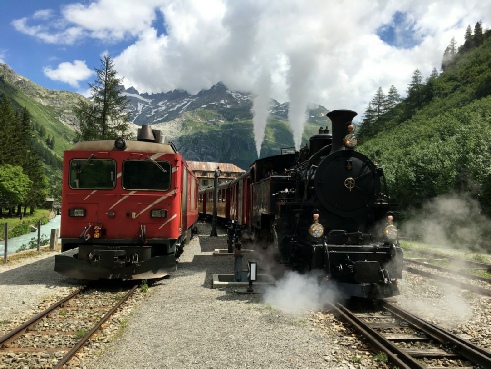
The fire train, which ran behind the steam service -
HG3/4 (number 4) and HGm4/4 (number 61) pass at Gletsch
Once through the tunnel, the train pauses to take on water at Furka station, where passengers have around twenty minutes to alight and admire the views, before continuing to Realp.
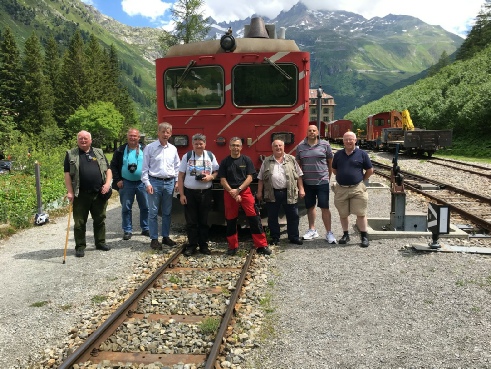
L&CI members pose with the locomotive we had travelled behind (and in the cab) prior to heading for lunch at the nearby hotel.
It was explained that the railway only operates for around seventy running days each year (from late June to early September), during which, the steam locomotives clock-
Volunteers not only maintain and repair the rolling stock, but also have the un-
All in all, this had been a fascinating day for all of us present. We had been treated exceptionally well (the paperwork described us as “official guests from British Rail”) by everyone we encountered, and they had gone out of their way to host us. As a show of our appreciation, The Institution made a donation of 100CHF to their welfare fund, to go some way to ensuring the railway continues operating for many seasons ahead.
For tonight, we were re-
Our final day started with a trip through the 57km Gotthard-
Today we had originally intended to be heading for Schaffhausen, using a special train being operated by Verbano Express. However, in the weeks running up to our visit, this was unfortunately postponed by one week, so alternative plans had to be drawn up.
After consulting with those who had booked, we opted to head to the impressive museum of the Chemin de fer touristique Blonay-
Travelling via Arth-
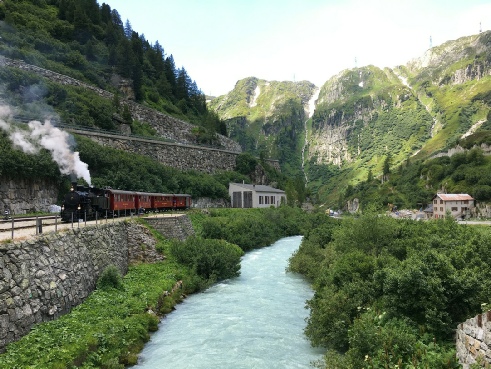
Our eastbound steam service arrives into Gletsch
TM 506 prepares to ‘bank’ our train through the Furka-
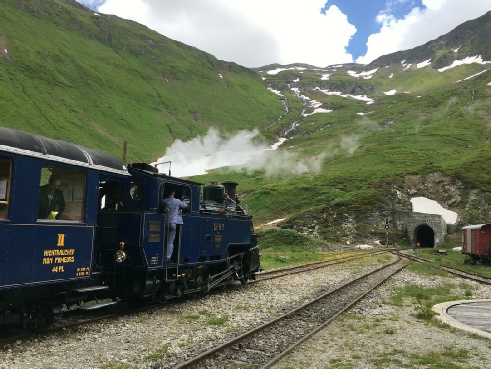
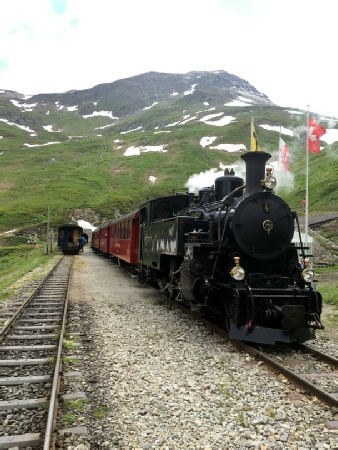
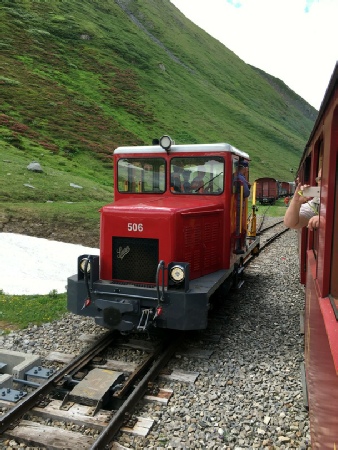
Steam hauled services crossing at Furka
Once back at Realp, we met Mr Christian Meier, who was to show us around the depot. We took the short walk along the approach road, and chatted about our day so far. By the time we arrived, our steam locomotive had already got there, and was in the process of being ‘cleaned’, having made its final run for the day. Next to the turntable and steaming bays, we were stood beside a huge pile of recently delivered coal, and got proudly informed that it was Welsh coal, as it was far superior to their previous supply from Poland.
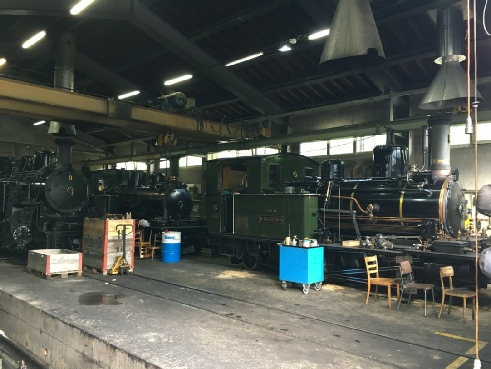
Inside view at Realp (DFB) maintenance shed, during our guided depot visit
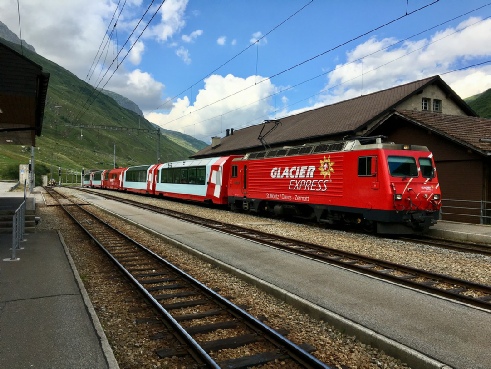
A St Moritz/Chur -
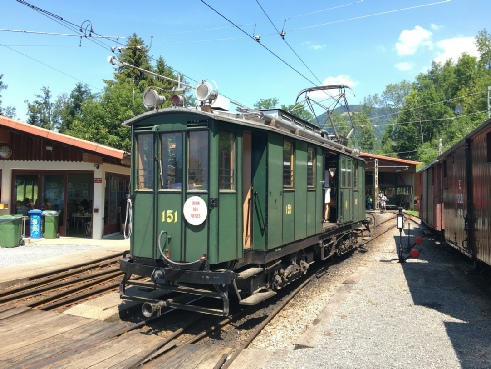
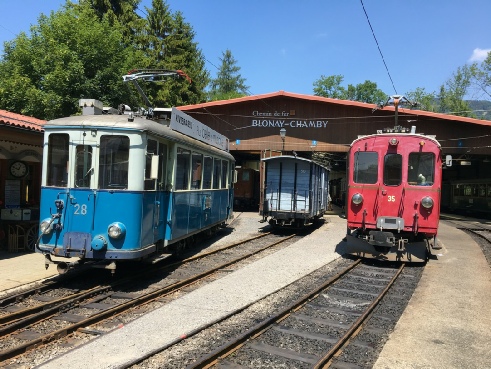
Tram cars at the Blonay-
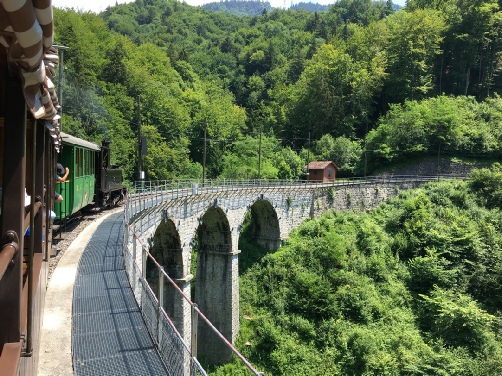
G3/3 (number 6) crosses the impressive Baye-
|
If you have enjoyed reading this web page, you may also be interested in our account of our visit to Switzerland in 2002. For further details click the button: |
|
|
As well as return visit to Switzerland in 2019 |
 Switzerland 2019
Switzerland 2019